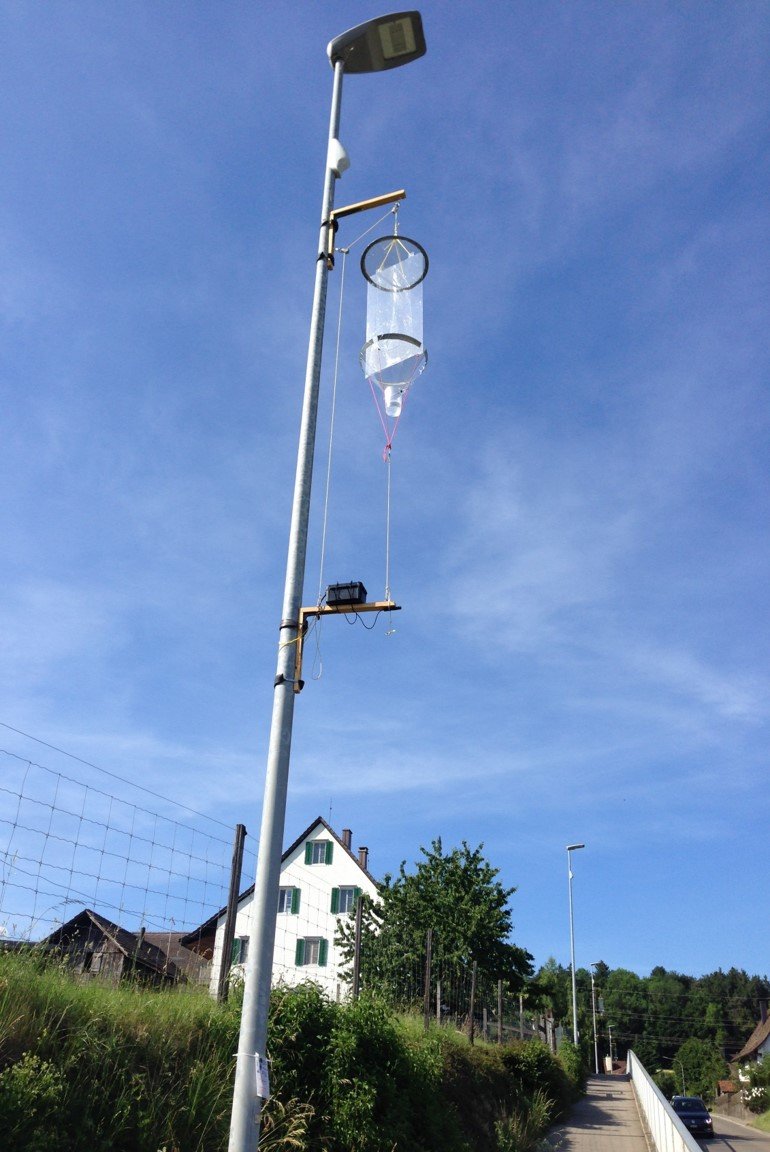Traffic-regulated street lights to reduce impacts of light pollution: Good news for nocturnal insects and bats?
Written By Janine Bolliger, Tom Hennet, Beat Wermelinger, Ruedi Bösch, Robert Pazur, Stephan Blum, Jörg Haller and Martin K. Obrist
9th June 2022
Light pollution is increasingly recognized as a threat to biodiversity and ecosystem functioning. Street lights are highly relevant contributors to artificial light at night (ALAN) with increasing importance due to high urban growth rates across the globe. At the same time, advancements in light-technology make it possible to modulate the light levels of LED street luminaires according to traffic volumes: light levels are increased when there is traffic and are reduced when there is none. Such dimming of street lights reduces the amount of light spread into the environment and may thus mitigate the negative effects of light pollution. We quantified the impact of traffic-controlled dimming of street lights on nocturnal insect abundance and bat activity in comparison to full light (i.e., dimming functions of luminaires switched off) in a field experiment along two main roads in peri-urban Switzerland during the summer of 2019. We mounted 20 insect flight-interception traps and ten batloggers on street-light poles along two dimmable street light sections (Fig. 1).
Figure 1. Flight-intersection traps are mounted to street-light poles to assess the abundance of nocturnal insects as a function of street light levels. The black box in the top left photo shows a device for recording acoustic signals of bats (batlogger). Photos: J Bolliger, MK Obrist, K. Soland.
Insect abundance and bat activity were measured alternatively: one week of full street lighting was followed by one week with light levels modulated by traffic. In total, 16 dimmed and 16 full-light nights were investigated. While the battery of batloggers had to be changed once a week, the insect traps were visited twice a day to ensure that only nocturnal insects were collected: the traps were activated in the evenings and the samples were collected early in the mornings and the lights turned off. We also retrieved mean nightly temperature and the precipitation levels from nearby meteorological stations. On average, traffic-controlled dimming reduced light levels by 35%. The most important variables affecting the amount of insects caught and the level of bat activity were warm and dry night-weather conditions. The second most important factor was the light regime: traffic-driven dimming resulted in lower numbers of insects caught and in reduced bat activity. This means that insects and bats were less attracted to street lights when lights were dimmed. Among insect groups, Heteroptera, often called ‘typical bugs’ or ‘true bugs’, benefited most from dimming (Fig. 2).
Figure 2. Total number of insects caught in the different insect groups, in full vs. dimmed light. Statistical significance of difference between full light and dimmed treatments are given on the right (*** = p < 0.01; * = p < 0.05; n.s. = not significant; - = not tested). Numeric values are given in the bars.
For bats, urban exploiters such as the common pipistrelle benefited from increased availability of prey at brightly lit street lights, while less abundant species and more light-sensitive bats, such as mouse-eared bats, could not profit from street lighting (Fig. 3). Thus, reducing the illuminance of street lights can help reduce the impact of artificial light on nocturnal animals. Nevertheless, the measure may not be efficient enough to allow light-sensitive and various threatened species to forage or move along streets because even dimmed luminaires may still be too bright for them.
Figure 3. Total and guild specific numbers of bat passes recorded in full vs. dimmed light. Significance of difference between the treatments are given on the right (* = p < 0.05; n.s. = not significant). Numeric values are given in the bars. LRE: long-range echolocators, MRE: mid-range echolocators (most common species, e.g. Common Pipistrelle); SRE: short-range echolocators.
We conclude that, in addition to weather conditions, the level of street light illumination is an important environmental factor explaining the occurrence of nocturnal insects at street lights. Lower levels of street lighting attract fewer insects and reduce the foraging facilitation of common urban bats, thereby probably impacting local insect and bat communities less than full lighting. Dimming of street lights may therefore become an important tool for mitigating the negative effects of ALAN on biodiversity by allowing for increased darkness between different habitats of nocturnal organisms, such as bats commuting between daytime roosts and foraging areas. While, ideally, dimmed street lights should be placed wherever possible, their installation and maintenance costs are substantial. Realistically, dimmable street light sections could be prioritized in areas with roads that fragment bat corridors or biodiversity-rich habitats. Particularly in urban areas, remnant habitats with low ALAN exposure are crucial in supporting urban bat populations. Therefore, increased multidisciplinary collaboration is needed between those possessing local biodiversity knowledge, ongoing initiatives related to green infrastructure, local authorities, conservation agencies, and the electrical companies installing and maintaining street lights.
Author information:
Janine Bolliger*, Tom Hennet*, Beat Wermelinger*, Ruedi Bösch*, Robert Pazur*, Stephan Blum+, Jörg Haller+, Martin K. Obrist*
* WSL Swiss Federal Research Institute, Zürcherstrasse 111, CH-8903 Birmensdorf, Switzerland
+ EKZ, Dreikönigstrasse 18, 8022 Zürich, Switzerland
Source:
Bolliger J, Hennet T, Wermelinger B, Blum S, Haller J, Obrist M. 2020. Effects of dimmed street lights on nocturnal insect abundance and bat activity. Basic and Applied Ecology 47: 44-56. DOI: 10.1016/j.baae.2020.06.003
Editor:
Clara Grilo and Rodney van der Ree
Cite this summary:
Bolliger J, Hennet T, Wermelinger B, Bösch, R, Pazur, R, Blum S, Haller J. & Obrist M. (2022). Traffic-regulated street lights to reduce impacts of light pollution: Good news for nocturnal insects and bats?. Edited by Grilo, C. and van der Ree, R. TransportEcology.info, Accessed at: https://transportecology.info/research/streetlight-impacts-insects-bats [Date accessed].







